 W
WA mosaic is a pattern or image made of small regular or irregular pieces of colored stone, glass or ceramic, held in place by plaster/mortar, and covering a surface. Mosaics are often used as floor and wall decoration, and were particularly popular in the Ancient Roman world.
 W
WCement tiles or hydraulic tiles are handmade colourful tiles used as floor and wall tiling. They appeared in Catalonia (Spain) in the 1850s, and have been widely used in Europe and America. They represented a revolution in flooring in their day because they were much cheaper, more durable and easier to make than the previous handmade glazed ceramic tiles and were therefore more universally available for houses, and they allowed for profuse decorative patterns, their age of splendour being the end of the 19th to the middle of the 20th centuries, before they were gradually superseded by newer technology as of the 1960s, such as terrazzo, salt-glazed stoneware, etc. that didn't allow for such decorative embellishment but were cheaper.
 W
WCosmatesque, or Cosmati, is a style of geometric decorative inlay stonework typical of the architecture of Medieval Italy, and especially of Rome and its surroundings. It was used most extensively for the decoration of church floors, but was also used to decorate church walls, pulpits, and bishop's thrones. The name derives from the Cosmati, the leading family workshop of craftsmen in Rome who created such geometrical marble decorations.
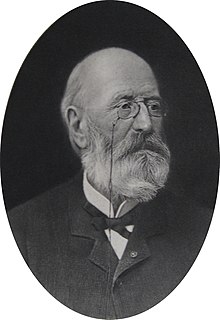 W
WEmaux de Briare is a French company specializing today in mosaics. Whilst the manufactory in Briare originally started with earthenware pottery, the factory founded in Paris by Jean-Félix Bapterosses (1813–1885) initially began manufacturing porcelain buttons in 1845. They merged in 1851, at which date its international development started: 1851 in The Great Exhibition, UK and as early as 1853 in the United States.
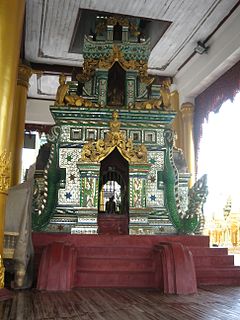 W
WGlass mosaic is a traditional Burmese mosaic made with pieces of glass, used to embellish decorative art, structures, and furniture. Glass mosaic is typically divided into two subcategories, hman gyan si (မှန်ကြမ်းစီ) and hman nu si (မှန်နုစီ). The former is typically used to decorate the walls and ceilings of pagodas, while the latter is used to embellish furniture and accessories. The art form originated in the 1500s during the Nyaungyan era. Glass mosaic is often studded with gems and semi-precious stones.
 W
WGlass tiles are pieces of glass formed into consistent shapes.
 W
WUnlike traditional mosaics which rely on differently colored material arranged in arbitrary configurations to make an image, impressionist mosaics are created using the natural flaws and marbling in the tiles to create the impression of an image. Depending on the definition, this may be limited to arranging square, homogeneously colored tiles in a grid-like, non-overlapped fashion.
Micromosaics are a special form of mosaic that uses unusually small mosaic pieces (tesserae) of glass, or in later Italian pieces an enamel-like material, to make small figurative images. Surviving ancient Roman mosaics include some very finely worked panels using very small tesserae, especially from Pompeii, but only from Byzantine art are there mosaic icons in micromosaic with tesserae as small as the best from the Modern period. Byzantine examples, which are very rare, were religious icons. The best known shows the Twelve Great Feasts of the Greek Orthodox Church and is in the Bargello in Florence. Another is in Rome and was crucial in developing the iconography of the Man of Sorrows in the West.
 W
WOpus tessellatum is the Latin name for the normal technique of Greek and Roman mosaic, made from tesserae that are larger than about 4 mm. It is distinguished from the finer opus vermiculatum which used tiny tesserae, typically cubes of 4 millimetres or less, and was produced in workshops in relatively small panels which were transported to the site glued to some temporary support. Opus tessellatum was used for larger areas and laid down at the final site. The two techniques were often combined, with small panels of opus vermiculatum called emblemata at the centre of a larger design in opus tessellatum. The tiny tesserae of opus vermiculatum allowed very fine detail, and an approach to the illusionism of painting. There was a distinct native Italian style of opus tessellatum using only black on a white background, which was no doubt cheaper than fully coloured work.
 W
WOpus vermiculatum is a method of laying mosaic tesserae to emphasise an outline around a subject. This can be of one or more rows and may also provide background contrast, e.g. as a shadow, sometimes with opus tessellatum. The outline created is often light and offset by a dark background for greater contrast. The name opus vermiculatum literally means "worm-like work", and has been described as one of the most demanding and elaborate forms of mosaic work. Usually opus vermiculatum is meant to put emphasis on the main design and foreground details of a work, using a smooth and flowing halo-effect. Sometimes it was used only around the head of a figure. The tesserae used were often square but can be variously shaped.
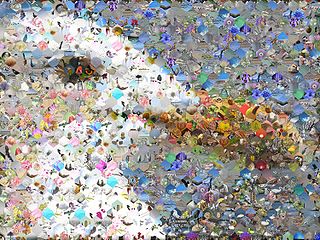 W
WIn the field of photographic imaging, a photographic mosaic, also known under the term Photomosaic, is a picture that has been divided into tiled sections, each of which is replaced with another photograph that matches the target photo. When viewed at low magnifications, the individual pixels appear as the primary image, while close examination reveals that the image is in fact made up of many hundreds or thousands of smaller images. Most of the time they are a computer-created type of montage.
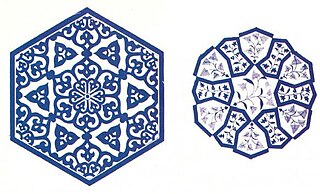 W
WQashani or Kashani is a Persian decorative arts which had been popular in Iran in the 16th to 18th century, and then moved to Turkey in the time of the Ottomans with the transfer of many Persians artists to Turkey, becoming the basis for decorating the walls of mosques, palaces, shrines and tombs. It is a square-shaped ceramic tile which uses Persian-like floral-depicting 4- or 6-sided glazed tiles, decorated with blue, cyan, green and sometimes red colors. The decoration is surrounded by fine black lines that make it stand out on its white floor. The tile work had often been decorated by the inscription, floral and geometrical patterns. The inscription often provides Qur'anic verses or sentences related to historical events written in Persian script. The plant often consists of natural flowers such as lily, cloves, roses and cypress trees. Geometrical patterns consists of different geometrical shapes and polygons. In Morocco, similar artistic technique is known as zillij. Its use has been widespread in the decoration of the walls of the buildings in the Ottoman era, and this mosaical feature can also be seen in the Dome of the Rock in Jerusalem. Kashi, the abbreviated form of Qashani, was also introduced to Sindh, Kutch, and Multan where numerous examples of shrines and mosques embellished with blue, white and green tile work exist.
 W
WA tiling or tessellation of a flat surface is the covering of a plane using one or more geometric shapes, called tiles, with no overlaps and no gaps. In mathematics, tessellations can be generalized to higher dimensions and a variety of geometries.
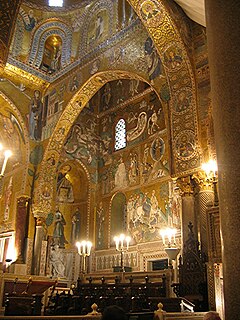 W
WA tessera is an individual tile, usually formed in the shape of a cube, used in creating a mosaic. It is also known as an abaciscus or abaculus.
 W
WA tile is a thin object usually square or rectangular in shape. A tile is a manufactured piece of hard-wearing material such as ceramic, stone, metal, baked clay, or even glass, generally used for covering roofs, floors, walls, or other objects such as tabletops. Alternatively, tile can sometimes refer to similar units made from lightweight materials such as perlite, wood, and mineral wool, typically used for wall and ceiling applications. In another sense, a tile is a construction tile or similar object, such as rectangular counters used in playing games. The word is derived from the French word tuile, which is, in turn, from the Latin word tegula, meaning a roof tile composed of fired clay.
 W
WTrencadís, also known as pique assiette, broken tile mosaics, bits and pieces, memoryware, and shardware, is a type of mosaic made from cemented-together tile shards and broken chinaware. Glazed china tends to be preferred, and glass is sometimes mixed in as well, as are other small materials like buttons and shells. Artists working in this form may create random designs, pictorial scenes, geometric patterns, or a hybrid of any of these.
 W
WThe xenia motif in Roman mosaic is a still life motif consisting of a grouping of various items, mostly edible, representing a generous offering from a wealthy host to his guests. The items are often spread across different compartments in floor mosaic schemes. No doubt there were once paintings, but these have been lost.
 W
WZellīj is a style of mosaic tilework made from individually hand-chiseled tile pieces set into a plaster base. The pieces were typically of different colours and fitted together to form elaborate geometric motifs, such as radiating star patterns. This form of Islamic art is one of the main characteristics of Moroccan architecture and medieval Moorish architecture. Zellij became a standard decorative element along lower walls, in fountains and pools, and for the paving of floors. It is found commonly in historic buildings throughout the region, as well as in modern buildings making use of traditional designs such as the Hassan II Mosque in Casablanca which adds a new color palette with traditional designs.